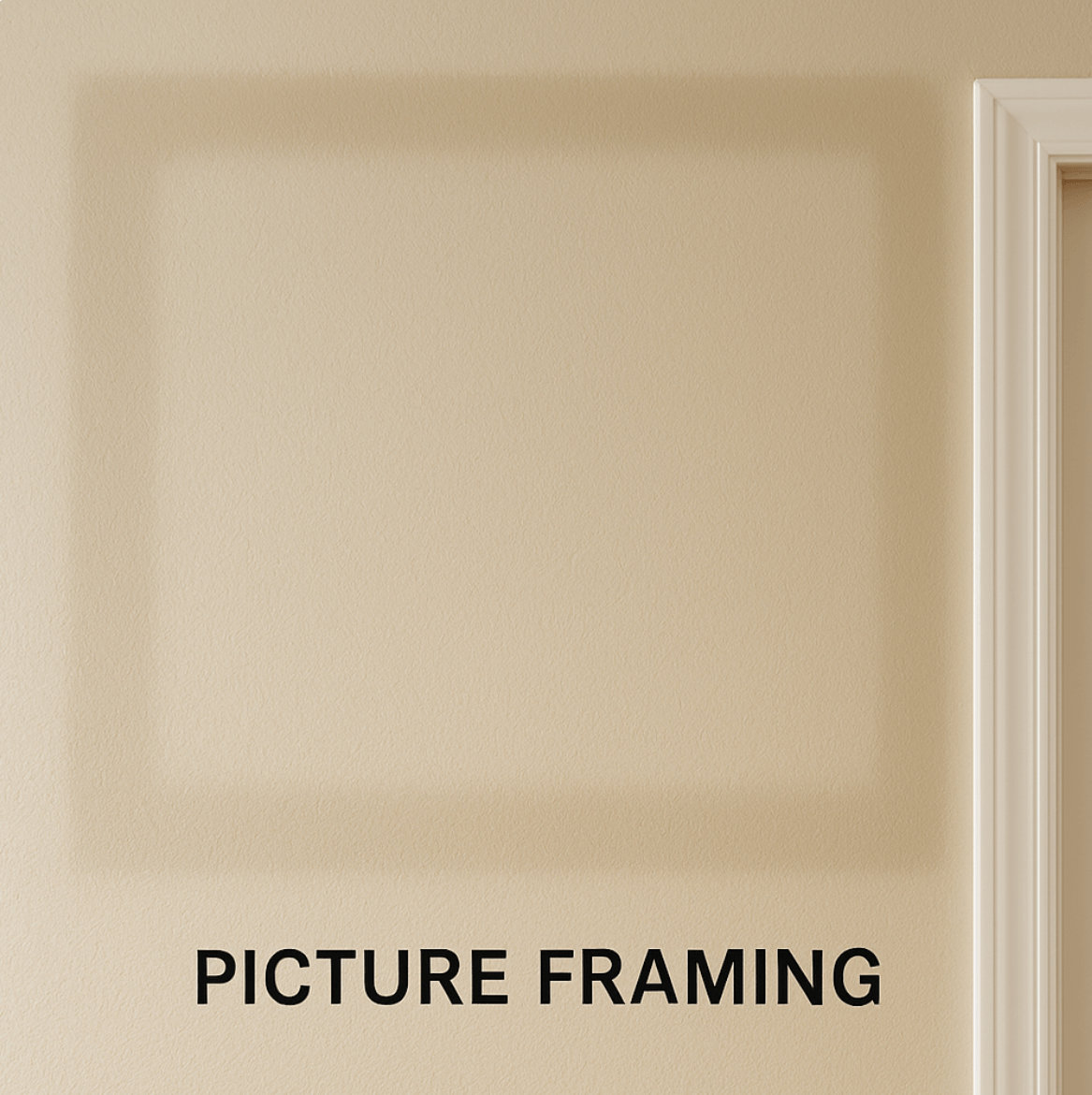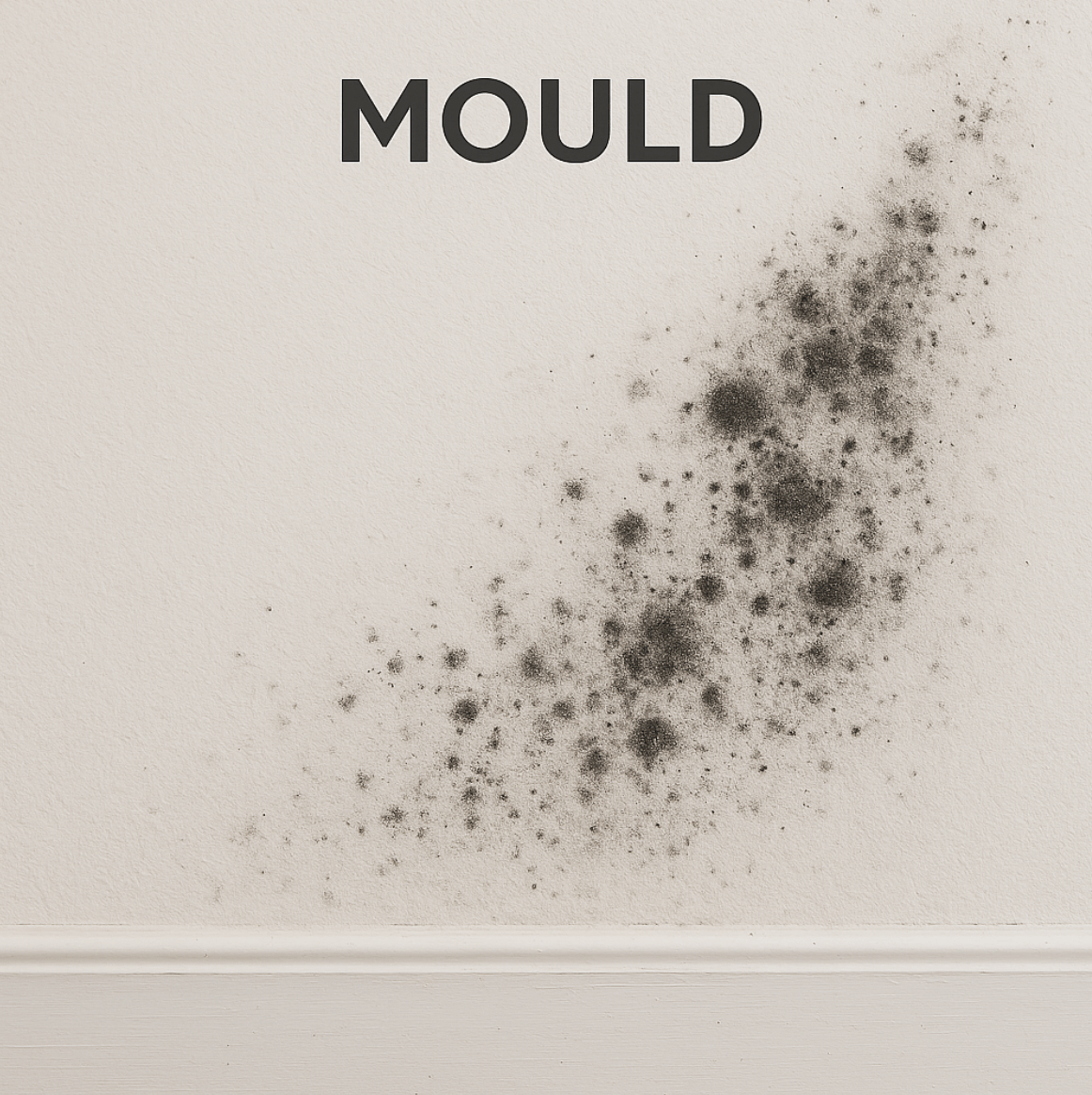Mould (in paint films): The growth of fungi on painted surfaces, usually appearing as black, green, or brown spots. It thrives in damp or humid conditions, can penetrate plaster or timber beneath the paint, and is often difficult to eradicate if moisture problems persist.
How it Looks
- Appearance: Irregular spots, patches, or streaks on the surface.
- Colours: Commonly black, dark green, brown, or grey; sometimes white and fuzzy in early stages.
- Texture: May look powdery, fuzzy, or slimy depending on the species and moisture level.
- Pattern: Often clustered in damp corners, behind furniture, near ceilings, bathrooms, laundries, or other poorly ventilated, humid areas.
- Progression: Starts as small specks and can spread into larger blotches; in severe cases, it penetrates through paint into plaster, timber, or other porous surfaces.
Causes:
- High humidity – areas such as bathrooms, laundries, and kitchens with steam and condensation.
- Poor ventilation – limited airflow allows moisture to linger on walls and ceilings.
- Moisture leaks – from plumbing, roofs, gutters, or cracked walls letting water into the substrate.
- Condensation – on cold surfaces where warm, moist air meets cooler walls or ceilings.
- Porous substrates – unsealed plaster, timber, or masonry that hold moisture.
- Shaded or damp areas – external walls or corners that don’t receive sunlight.
- Contaminated surfaces – dirt, dust, or organic matter left on surfaces can provide nutrients for mould growth.
- Painting over damp surfaces – trapping existing moisture beneath the paint film.
How to fix mould growth
You’ll need
Protective gloves • Safety glasses • P2/N95 mask • Drop sheets • Bucket & sponge • Scrubbing brush • Household bleach (sodium hypochlorite) or commercial mould remover • White vinegar (alternative) • Mild detergent • Clean water • Microfibre cloths • Stain-blocking primer (anti-mould) • Quality paint with mould-resistant additives • Caulk/sealant
Step 1 — Safety first
- Wear gloves, goggles, and a mask to protect from spores and cleaning chemicals.
- Ventilate the space by opening windows and doors.
Step 2 — Identify & fix the moisture source
- Check for leaks, condensation, rising damp, poor ventilation, or plumbing issues.
- Repair or improve airflow (e.g., add exhaust fans, dehumidifiers).
- Unless the source of moisture is resolved, mould will return.
Step 3 — Remove surface mould
- Mix 1 part household bleach with 3 parts water (or use a commercial mould remover).
- Apply to the mouldy area with a sponge or spray bottle.
- Leave for 15–20 minutes.
- Scrub gently with a brush or sponge until mould is removed.
- Rinse thoroughly with clean water and allow the surface to dry completely.
(Alternative: undiluted white vinegar can be sprayed on, left for 1 hour, then rinsed.)
Step 4 — Treat stained or damaged surfaces
- If mould has left staining, sand lightly and prime with a stain-blocking, anti-mould primer.
- For severe cases where mould has penetrated plasterboard or timber, replacement of affected material may be necessary.
Step 5 — Repaint
- Apply two thin coats of quality paint formulated with mould-resistant additives.
- Follow manufacturer’s drying and recoat times.
Step 6 — Prevention strategies
- Improve ventilation in bathrooms, laundries, and kitchens (exhaust fans, windows).
- Use dehumidifiers in high-humidity areas.
- Regularly clean painted surfaces with mild detergent and water.
- Re-seal gaps around windows, doors, and plumbing to prevent water entry.
Tip: Always test cleaning solutions on a small area first, and never mix bleach with ammonia or other cleaners.
Scraper • Utility knife • 240–320 grit sandpaper • Filler/patching compound (substrate-appropriate) • Sugar soap/mild detergent & water • Clean rags/tack cloth • Primer (see Step 6) • Quality topcoat • PPE (gloves, dust mask, safety glasses)
Step 1 — Safety check
- If the home may have old paint (e.g., pre-1970s), assume lead and follow local lead-safe practices or use a pro.
- Isolate the area; wear PPE; lay drop sheets.
Step 2 — Diagnose the cause (moisture vs heat/solvent)
- Slice a blister:
- Only topcoat lifts; undercoat intact → likely heat/solvent entrapment or poor intercoat adhesion as a result of surface contamination.
- Peels to bare substrate (often damp) → moisture problem.
- If exterior, inspect flashings, joints, caulking, gutters, leaks.
- If interior (bathrooms, laundries), check ventilation/fans and plumbing.
Step 3 — Fix the source before cosmetic repair
- Moisture: repair leaks, improve drainage/caulking/ventilation; let the substrate dry completely (timber should be dry to the touch—use a moisture meter if available).
- Heat/solvent: avoid painting in direct sun or on hot surfaces; respect recoat times; don’t over-thicken/over-apply.
Step 4 — Remove failed paint
- Cut the blister edges with a sharp knife; scrape all loose/flaking film back to sound, well-adhered coating.
- Fill depressions with a suitable proprietary filler.
- Feather-sand the edges (240–320 grit) until smooth.
Step 5 — Clean & de-chalk
- Wash the area with sugar soap/detergent, rinse, and let dry.
- Wipe off dust with a tack cloth. The surface must be clean, dry, and dull.
Step 6 — Prime correctly (match to substrate & cause)
- Bare timber: quality acrylic or oil-based wood primer; use a stain-blocking primer for tannin-rich timbers.
- Masonry/render: alkali-resistant masonry primer; brush off efflorescence before priming.
- Previously moisture-affected areas: choose a breathable (vapour-permeable) system and re-seal joints/edges.
- Intercoat adhesion issue: apply a bond/undercoat primer compatible with both old and new paints.
Step 7 — Patch & sand (if needed)
- Fill divots or edges with suitable filler/patching compound.
- Let cure fully; sand smooth and dust off.
Step 8 — Repaint under good conditions
- Apply two thin, even coats of quality paint (brush/roller/spec as per manufacturer instructions).
- Observe recoat times.
- Work in shade, ideal temp cool to mild, and avoid windy/dusty conditions.
Step 9 — Seal vulnerable points
- Re-caulk gaps around trims, windows, and penetrations; seal top/bottom edges of exterior doors and boards.
Step 10 — Prevent recurrence
- Maintain gutters/flashings; keep sealants intact.
- Use exhaust fans in wet areas.
- Avoid painting hot substrates and thick coats; always follow the can’s data sheet.
When to call a pro
- Widespread blistering over large areas, recurring moisture (rising damp, hidden leaks), or lead-based paint removal.







